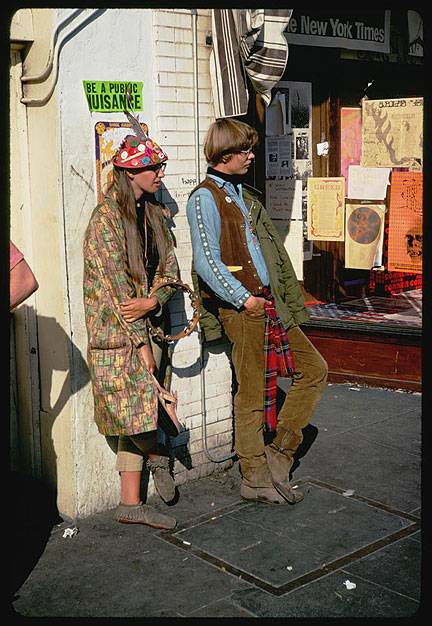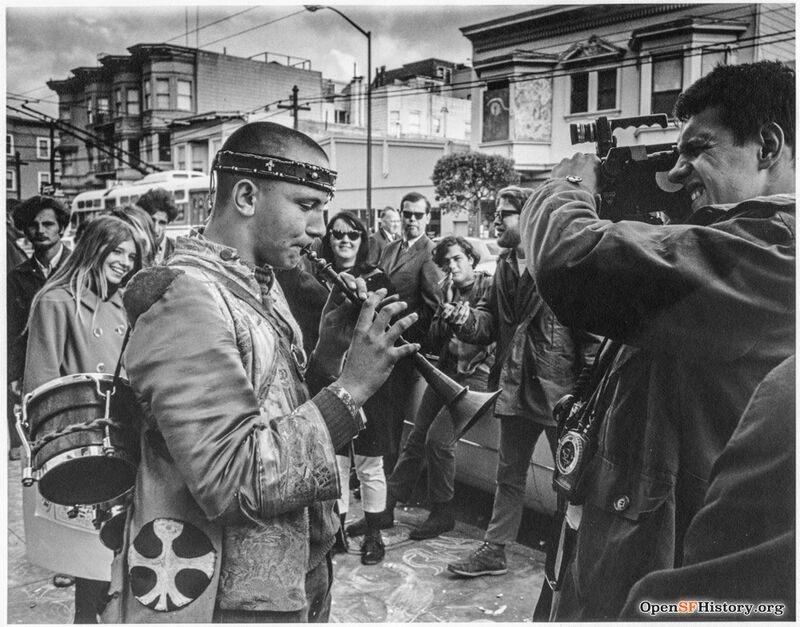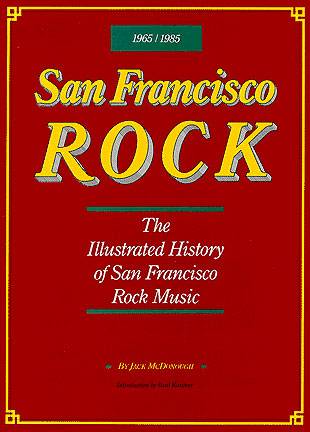The Psychedelic Era
Historical Essay
Hippies on Haight Street, October 26, 1967.
Charles Cushman Collection: Indiana University Archives (P15596)
The songs of the Jefferson Airplane were decidedly uneven in quality, but at their best, they comprise some of the most innovative music to come out of rock. Their second LP Surrealistic Pillow quickly became the most popular recording of the "Acid Rock" movement. As a political/social satirist Grace Slick was unsurpassed by anyone in the genre. Among her finest work must be included "White Rabbit," "Greasy Heart," "Rejoyce," "Lather," "Mexico," and the "Ballad of the Chrome Nun." An excellent singer with a powerful and fluid voice, she and Marty Balin were an arresting vocal duet, combined with the haunting guitar of Jorma Kaukonen and the locomotive bass of Jack Cassidy.
Hippie musician playing horn with video cameraman filming him amidst onlooking crowd.
Photo: OpenSFHistory.org wnp27.5954
Through the acid wit of Grace Slick and the unabashed optimism of Paul Kantner, the Airplane provided anthems for those disenfranchised by the cultural vacuousness and bankrupt sensitivities of the dominant society in mid-20th century America. The LP Volunteers featured the revolutionary lyrics "We Can Be Together" and "Volunteers of America." The moving ballad "Wooden Ships" tells the story of people, unable to live in the world as it is, boarding great ships and sailing away to shores unknown where a world of infinite possibilities awaits. If this sentiment seems naive and childlike, it is a vision not unworthy of the great poet William Blake.
When Marty Balin left the group after the Volunteers LP, the quality of the band took a decided downturn. Its resurrection as the Jefferson Starship produced a well-meaning attack on the capitalist economic system entitled Blows Against the Empire, but the material, regretfully, never quite lived up to the earlier work of the Airplane.
Grateful Dead play on flatbed truck at Haight and Cole, 1966
Photo: Jack McDonough
Grateful Dead, 1967
Video: LondonRadioBigBeat
While the Grateful Dead rarely spoke directly of political matters in their songs, they invariably conveyed the spirit of a group of social misfits having gone off to create its own culture and to make its own fun. No song better represents this attitude than "Uncle John's Band" which became the ultimate Deadhead classic in later years.
The band's first recording set the tone of the psychedelic era both in its music and its cover art. Anthem of the Sun, the group's second release, was as strange a concoction of material as rock music ever produced. Spurred on by Phil Lesh, a former student of the "avant-garde" electronic music program at Mills College, this bizarre album attempted to combine electronic and tape composition with Jerry Garcia's folk/blues guitar style. The result, while a bold and laudable attempt at experimentation, was at best enigmatic. In many ways, however, it is a pity the group never continued to develop and refine this area of musical exploration.
Following Anthem of the Sun the Grateful Dead seemed to settle into a more comfortable voice with a kind of folk/country/blues mix, which kept it consistently one of the most popular rock ensembles until the death of Jerry Garcia in 1995. Of particular note are the songs "Casey Jones," "Sugar Magnolia," and "Friend of the Devil."
The Quicksilver Messenger Service formed the third of the triumvirate of San Francisco rock bands. Featuring the talents of guitarist John Cippolina, Quicksilver's first LP included a 12-minute work entitled "The Fool," which is a veritable compendium of electronic guitar technique at that time. This piece was also notable as an extended composition, rather than just a song with an improvised "jam-session" in the middle.
On its third release, Quicksilver recorded one of the most defiant statements of the insurgent counter-culture, "What'cha Gonna Do About Me?"
Chronicle Books, San Francisco, CA
Hippies Beautiful 1967 San Francisco
Video: NAAACTR




